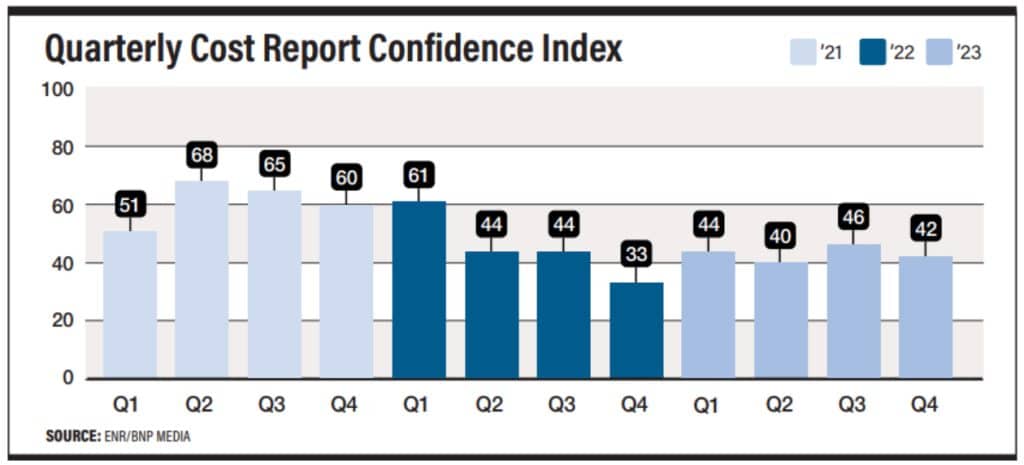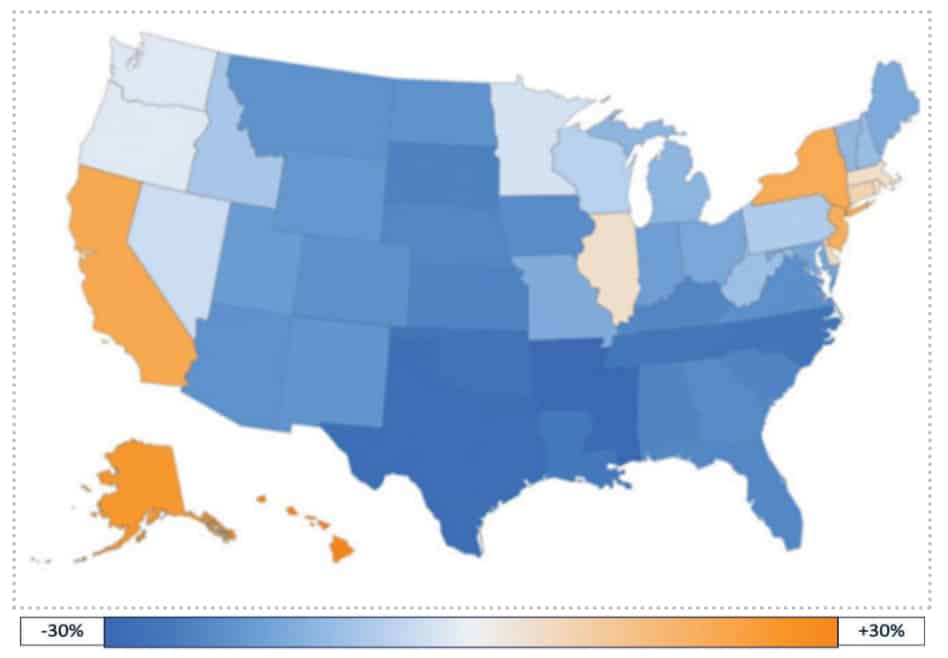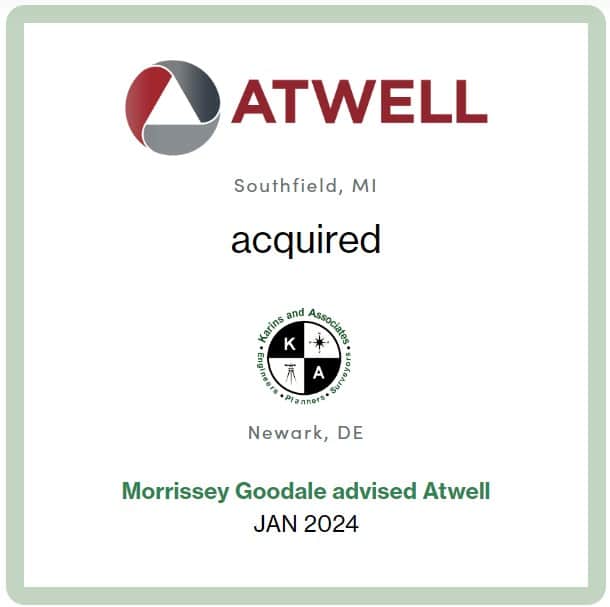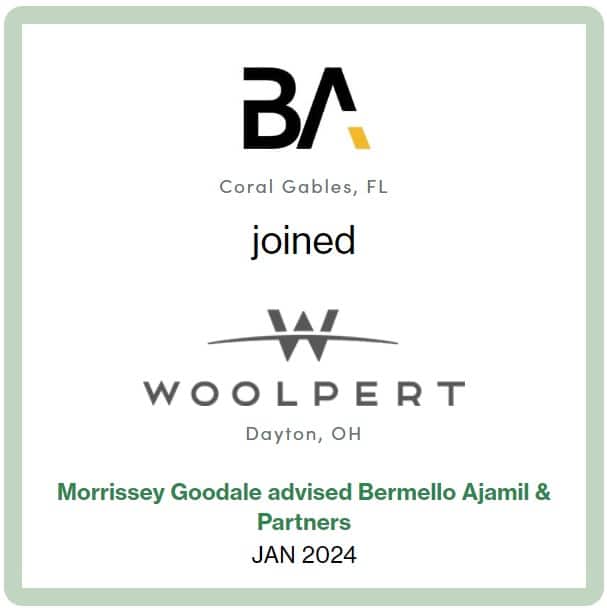Word on the street > The Wild West of AI and Machine Learning for the AE Industry; 10 Strategic Planning Troublemakers
Word on the Street: Issue 181
Weekly real-time market and industry intelligence from Morrissey Goodale firm leaders.

The Wild West of AI and Machine Learning for the AE Industry
In many ways the world of artificial intelligence (AI) and machine learning (ML) feels a lot like the Wild West and the American frontier. Burgeoning promise and potential. Fortunes to be made. Rumors of riches in them thar hills. Rules, regulations, and governance being made up in real time. Ambitious adventure seekers and pioneers. Naïve prospectors. New ways of doing things. Baseless claims. Hucksters. Rich seams to be mined. Gold Rush fever. More than a little “All Hat, No Cattle” in play. (Full disclosure, I just finished watching Deadwood.)
From a strategy perspective, I’m struck by the advocacy of industry CEOs to exploit the technology. In the past, investment in new technologies was for the most part championed by CIOs and directors of IT. These technologies promised evolutionary business process improvements in quality, speed, and efficiencies that may or may not translate into improved profits. AI is different. It promises to be transformational for businesses. And CEOs are all in. They just want to know where to start.
It seems like every AE and environmental consulting firm leadership team is trying to figure out how to find and quickly mine the AE and ML gold in them thar hills. Some 40% of the attendees for our upcoming Southeast M&A and Business Symposium are already using AI in their businesses for marketing and business efficiencies, and 32% are exploring how to take advantage of the technology. Perhaps the best guide to navigate this new landscape is someone who understands not only AI and ML but AI, ML, AND AE—as in the AE industry.
One such firm is Thrivence (Nashville, TN), which is the management consulting subsidiary of AE industry leader Barge Design Solutions (Nashville, TN) (ENR #169). Thrivence provides strategy, leadership development, and technology—including AI and ML—solutions to Barge’s public- and private-sector clients. I sat down with Bob Higgins, CEO of Barge, and Gary McClure, senior consultant at Thrivence, for a discussion about how AI and ML are right now shaking up the AE Industry.
MG: You’ve been pioneers in terms of helping your clients figure out AI and use it to generate revenues and earnings for them. Can you tell us what types of clients you’re working for in this regard and how you’ve been helping them?
Thrivence/Barge: Generative AI is still in its infancy. The interest in AI is still growing as leaders continue to hear about potential opportunities and even challenges of integrating AI in their organizations. These leaders want to get trusted insight, but they don’t know where to turn.
Where we found we can be most helpful is being that “interpreter” of artificial intelligence for the everyday business leader. We can be a bridge between the overwhelming amount of AI information currently being hyped and the organizational leaders who need to understand it at a strategic level and an operational one. Leaders are turning to us to filter out the technical jargon and media superlatives that we all tend to hear.
MG: Can you provide some real-life examples?
Thrivence/Barge: Sure, here are some specific examples. Based on our experience, these are just a few of the applications that are relevant for almost every AE or environmental consulting firm. These are examples of how AI and ML can be used to improve enterprise-wide performance and better serve clients and improve services.
- Worker acquisition: An engineering firm was struggling to attract quality candidates for key roles. AI was used to optimize job postings aimed at particular experiences desired. AI also assisted in developing content to authentically tell the firm’s story as well as propel an internal referral program. Efforts have doubled traffic to postings and dramatically increased applications.
- Enhanced coding and workflow: An engineer applied AI to aid in automating data analytics. He built prompts for extracting data from images, building programming code, and highlighting risk in contract reviews.
- Reduced costs: We generated cost savings using AI/ML/image recognition to build software that reduced man-hours for a client’s asset management program.
- Improved sales: We worked with an AE firm to reimagine how they positioned themselves in the marketplace. We helped them use AI and image-recognition AI tools to create a marketing and communications plan for a major project they were leveraging with other clients. The plan included a user generated content (UGC) strategy, a marketing strategy, and a social media campaign…all from a photo of the project.
MG: What’s the headline application of AE and ML in the AE industry?
Thrivence/Barge: Applying AI and ML in AE firms to facilitate the shift from hourly rate billing to a value-based billing model has been one of the primary learning areas. AI has the potential to significantly boost productivity, which allows businesses to more efficiently offer exceptional value to clients. Therefore, an hourly rate system is not economically viable. Instead, how can firms estimate the overall value of work provided?
MG: You’re also becoming an AI thought leader and educator with your recent partnership with Vanderbilt University. Tell us more about that collaboration. Who are you looking to educate with it and what are you looking to bring to them?
Thrivence/Barge: This is the first technology in our careers that can do two major things AE industry CEOs have needed for a long time. First, give us more time in our day, and second help us capture value-billing opportunities and move away from the hourly-rate billing structure we have lived by in our entire careers.
Our partnership with Vanderbilt will quickly scale our ability to train our people to use these AI tools, like machine learning, robotics process automation, and image recognition. Vanderbilt is a global leader in the future of learning and generative AI. They will also help us bring AI along as “augmented intelligence” and an exoskeleton for our brain. Finally, we will partner with them and our clients on research opportunities that will improve our ability to scale AI in infrastructure design more quickly to meet the current demands in our industry.
MG: How do you see AI playing out in the AE and environmental consulting industry? What are the big benefits for CEOs and executive teams? What opportunities does AI present for design and environmental firms?
Thrivence/Barge: We’re hearing some pretty creative and thoughtful ways AE firms are applying AI. But the benefits tend to be associated with the standard areas of operational efficiency, optimizing time, and reducing errors and expenses. It’s also being used to decrease risk as well as enhance business service teams (productivity).
We outlined some specific use cases in our recent video masterclass on AI for AE firms. For example, design optimization where algorithms can create numerous design variations by altering parameters such as materials cost and spatial requirements. This helps architects and engineers quickly explore a wide range of design possibilities.
No doubt we’ll continue to see new ideas evolve as firms explore ways to implement AI. Our goal is to find ways to best share those successes (and even failures) with other firms so we can learn from each other.
MG: Do you see AI primarily being used by the largest firms in the industry?
Thrivence/Barge: Larger firms likely have more resources than smaller ones to dedicate to AI implementation. So, we see their use cases are grander in scale and, perhaps, impact. But another interesting perspective on AI is that it’s an effective “field leveler.” By that we mean small firms can integrate AI and generate proportionally similar positive impact as much larger organizations. It doesn’t necessarily require massive capital and resource outlays for AI to make a meaningful contribution to a firm’s operations. In short, we are convinced that AI is applicable, as we demonstrate in our course, to every CEO and their team in the industry.
MG: When you’re advising clients where to prioritize their efforts or decision-making around AI, what are you telling them?
Thrivence/Barge: Prioritization is highly situational. That’s why we recommend CEOs explore potential opportunities to apply AI based on their specific needs. We don’t believe it can be a one-size-fits-all approach. What’s a “golden ticket” for one firm may not be as relevant for others.
So, we advise first dedicating time on the front-end working with employees at all levels of the firm and across functional areas. They’re going to generate the best ideas for where to start with AI. Give them the skills and resources to embrace AI in their areas of responsibility. Engaging employees has a positive amplifying effect, from generating internal excitement and buy-in to uncovering the best ways to pilot AI. If leaders think employees first, then technology, AI adoption happens quicker and with less drama.
We’ve found that it’s optimal that CEOs pursue AI use cases that address customer needs or internal enterprise issues. Integrating AI in your organization is not about chasing the technology, for it is ever-changing and too fluid to be “managed.” Focus first on what brings value to the organization and those you serve.
MG: Is there a simple step-by-step process that AE CEOs and executive teams can follow to begin to harness the power of AI?
Thrivence/Barge: Yes. We simplify the process by segmenting AI implementation into three phases: preparation, pilots, and post. We have a practical (and free!) AI implementation guide (available here) for AE and environmental consulting firm leaders. The guide highlights critical success factors such as equipping the leadership team with AI fundamentals, tapping into teammates at all levels of the firm, building diverse cross-functional teams, crafting AI guidelines or governance, and measuring everything as you learn.
MG: As I mentioned up top, my read is that one of the reasons that AI (and ML) will be so transformative for the AE industry is that unlike prior technologies, it is being evangelized by CEOs and not exclusively by CIOs or IT directors. What’s the one piece of advice you’d give a CEO who is beginning to explore AI and its potential?
Thrivence/Barge: While research and planning are prudent, we encourage leaders to just jump in and try AI. Implement it with one or two “low-risk” use cases. Continually assess the process and react to it. Measure everything along the way, too. In other words, learn by doing. It’s like taking a leap into a swimming pool. Sure, it’s a shock when you hit the water, but you adapt quickly and keep your head above water.
MG: Thank you, Gary and Bob. For our readers, should you wish to know more about Thrivence and how they can assist you on your AI journey, Gary will be joining us in Miami this March for our Southeast M&A and Business Symposium. Indeed, it’s a busy spring calendar of AI and Innovation for the industry—see below.
March: A focus on AI and innovation: If you’d like to know how to turn AI and ML into a competitive advantage for your firm, then our Southeast M&A and Business Symposium in Miami this March is the place for you. Morrissey Goodale Principal Brendon Cussio will be leading a workshop, “Making AI a Competitive Advantage for Your Firm.” And in a first for the industry, we will be hosting “The Innovation Incubator for the AE Industry” in collaboration with Shadow Partners (Atlanta, GA) where five of the most exciting start-ups for the built environment will be presenting their AI- and ML-powered business ideas.
April AI Summit: Our friends at BST Global (Tampa, FL) are hosting the industry’s first AI Summit on April 16-18 in Clearwater, Florida. It’s shaping up to be a stellar event. You can read all about it here.
To connect with Mick Morrissey, email him at [email protected] or text him at 508.380.1868.
Word on the Street “First Look at 2024 Compensation” Survey
Since 2020, industry raises and bonuses have been off the charts, and from what we’re hearing, 2024 looks like another big year for compensation increases. We’re conducting our “First Look” survey to help readers begin their compensation planning for 2024. Please take this quick, confidential, and anonymous survey below. We’ll slice and dice the data to organize anticipated raises and bonuses by firm size and type, as well as see how the results differ from last year. The results will be rolled out at our Southeast M&A and Business Symposium in March and made widely available thereafter.
2024 Raises and Bonuses Survey
10 Strategic Planning Troublemakers
Strategic planning is a critical process for AE firms, guiding their direction and growth. However, amidst the brainstorming sessions and goal-setting meetings, there are certain individuals who can really gum up the works. Here we identify 10 types of disruptive characters, explore how they can hinder strategic planning efforts, and provide suggestions on how to help them become productive members of your team.
1. Clyde Cynic
Clyde Cynic is the perpetual naysayer, always quick to shoot down ideas without offering constructive feedback. During strategic planning sessions, Clyde dampens enthusiasm by highlighting potential pitfalls without proposing solutions.
Clyde Cynic in action: During a recent strategic planning session, Clyde dismissed a proposal to expand into a new market, citing potential risks and challenges without offering alternatives. His pessimistic outlook dampened the team’s enthusiasm, leaving them feeling discouraged and unmotivated.
How to help Clyde Cynic: Encourage Clyde to voice concerns but also challenge him to suggest alternative approaches. Redirect the conversation towards problem-solving rather than dwelling on obstacles.
2. Distracted Dana
Distracted Dana is notorious for her inability to focus during meetings. She frequently checks her phone, doodles on her notepad, or engages in side conversations, derailing the flow of strategic discussions.
Distracted Dana in action: Last month, as the team discussed key priorities for the upcoming year, Dana continuously checked her phone, occasionally chiming in with irrelevant comments. Her lack of focus derailed the conversation, prolonged the meeting, irritated the rest of the team, and prevented meaningful progress.
How to help Distracted Dana: Set clear meeting agendas and ground rules for participation. Assign Distracted Dana specific tasks to keep her engaged, and constructively remind her of the importance of active, focused participation.
3. Micromanaging Max
Micromanaging Max tends to delve into minutiae, losing sight of the bigger picture. He insists on controlling every aspect of the strategic planning process, stifling creativity and innovation.
Micromanaging Max in action: Throughout last year’s strategic planning process, Max insisted on reviewing every detail of the strategic plan from font sizes to color schemes, micromanaging the creative process. His fixation on trivialities stifled innovation and creativity, frustrating team members who felt their autonomy was compromised.
How to help Micromanaging Max: Establish clear roles and responsibilities for team members, emphasizing trust and autonomy. Encourage Max to delegate tasks and focus on overarching goals rather than toiling away on the details.
4. Debbie Dream-Crusher
Debbie Dream-Crusher has a knack for extinguishing enthusiasm with her pessimistic outlook. She dismisses ambitious ideas as unrealistic and insists on sticking to safe, conventional strategies.
Debbie Dream-Crusher in action: In the early stages of the strategic plan, when a team member proposed an ambitious goal to double revenue within the next two years, Debbie immediately shot down the idea, citing budget constraints and market uncertainties. Her negative attitude out of the gate extinguished enthusiasm, leaving the team feeling deflated and uninspired.
How to help Debbie Dream-Crusher: Acknowledge Debbie’s concerns but challenge her to explore the potential benefits of bold initiatives. Remind her that, at this early stage, the goal is to encourage big, bold thoughts from the team. There will be plenty of time to diverge thinking later in the process.
5. Procrastinating Pete
Procrastinating Pete always leaves tasks until the last minute, causing delays and disruptions in the strategic planning process. He frequently misses deadlines and fails to follow through on commitments.
Procrastinating Pete in action: Despite being assigned a crucial research task weeks in advance, Pete waited until the day before the strategic planning meeting to start his work. His procrastination caused delays in the decision-making process, forcing the team to rush through discussions without adequate preparation.
How to help Procrastinating Pete: Break down tasks into smaller, manageable chunks with clear deadlines. Hold Pete accountable for his responsibilities and provide support, encouragement, and perhaps executive coaching to help him overcome procrastination habits.
6. Egoistic Emily
Egoistic Emily constantly seeks validation and recognition, often at the expense of collaboration. She monopolizes discussions, disregards input from other team members, and prioritizes her own agenda over collective goals.
Egoistic Emily in action: During a brainstorming session, Emily dominated the conversation, dismissed any ideas that weren’t hers, and relentlessly pushed her own agenda. Her unwillingness to consider alternative viewpoints stifled collaboration, creating significant tension within the team.
How to help Egoistic Emily: Foster a culture of inclusivity and collaboration where every team member’s contribution is valued. Provide candid feedback to Emily, balanced with encouragement to actively listen to others and recognize the importance of teamwork in achieving strategic objectives.
7. Change-Averse Charlie
Change-Averse Charlie is resistant to new ideas and approaches, clinging to traditional methods even when they no longer serve the firm’s interests. He views strategic planning as a threat to the status quo and resists any attempts to innovate.
Change-Averse Charlie in action: When presented with innovative strategies to adapt to changing market trends by some of the firm’s rising leaders, Charlie immediately dismissed them as unnecessary and insisted on maintaining the firm’s existing business model. His resistance to change hindered the firm’s ability to stave off rivals who were nipping at their heels.
How to help Change-Averse Charlie: Educate Charlie about the benefits of embracing change and adaptability in a dynamic industry. Highlight success stories of firms that have pivoted in response to changing market conditions. Be clear about what would change and—at least as important—what would not.
8. Overbearing Olivia
Overbearing Olivia dominates discussions with her strong personality, leaving little room for input from others. She imposes her opinions on the group and ridicules dissenting views, creating a stifling atmosphere.
Overbearing Olivia in action: Several months ago, Olivia dominated the strategic planning kickoff meeting, cutting off other team members and marginalizing their contributions. Her overbearing demeanor intimidated quieter team members, stifling open communication and collaboration. Buy-in ended up being a big problem throughout the rest of the process, and predictably, implementation of major initiatives was practically non-existent.
How to help Overbearing Olivia: Facilitate open and inclusive discussions where every team member uses their voice early and often. Encourage Olivia to practice active listening and consider alternative perspectives. Help her distinguish between assertions and assessments, and coach her to listen for comprehension, not agreement.
9. Perfectionist Paul
Perfectionist Paul sets impossibly high standards for himself and others, leading to unrealistic expectations and undue pressure. He fixates on minor details and delays decision-making in pursuit of an unattainable level of perfection.
Perfectionist Paul in action: Paul obsessed over minor details of the strategic plan, spending hours nitpicking grammar and formatting instead of focusing on overarching goals. His perfectionism slowed down the decision-making process and exasperated team members eager to make progress.
How to help Perfectionist Paul: Emphasize the importance of progress over perfection, focusing on incremental improvements rather than striving for flawless outcomes. Help Paul prioritize tasks and set realistic goals to avoid paralysis by analysis.
10. Neglectful Nadia
Neglectful Nadia is disengaged and indifferent during strategic planning sessions, showing little interest in the firm’s long-term goals. She fails to prepare adequately and contributes minimally to discussions, hindering progress.
Neglectful Nadia in action: During last week’s strategic planning session, Nadia remained silent and disengaged, failing to contribute meaningfully to the discussion. She appeared unprepared and indifferent to the firm’s long-term goals, hindering progress and infuriating her colleagues.
How to help Neglectful Nadia: Provide Nadia with clear expectations and communicate the importance of her participation in strategic planning efforts. Offer support and guidance to help her understand the significance of her role in shaping the firm’s future.
By recognizing and effectively managing the diverse challenges presented by disruptive behaviors, you can cultivate a collaborative environment conducive to envisioning your firm’s future and crafting a roadmap to achieve it.
For more information on how Morrissey Goodale can help your strategic planning process, call Mark Goodale at 508.254.3914 or email [email protected].
Market Snapshot: Engineering and Construction Costs
Weekly market intelligence for AE and environmental industry leaders.
We reviewed three different engineering and construction cost reports. Here are the highlights:
ENR’s Fourth Quarterly Cost Report: The report, released in late December, states that interest rates are likely to remain elevated until the second half of the year and starts will be relatively slow for private markets until then.
- Cost indexes are expected to be lower for most categories in 2024.
- Materials prices are likely to drop in 2024 for 7 of the 11 categories listed.
- The industry confidence index was down 4 points, to 42 at the end of 2023 (a rating above 50 shows a growing market).
- Confidence is highest (51) among firms that list the Midwest as one of their primary work regions.

Gordian’s Quarterly Construction Cost Insights Report: Critical challenges identified involve shortages in commodities and labor, leading to significant backlogs in mechanical, electrical, and plumbing equipment.
- Material costs remain high but are stabilizing.
- Areas located further away from the Mississippi River and the major manufacturing and industrial centers in the central U.S. tend to have higher material costs.
- The Southeast and Mountain states have lower labor costs.
Average Total Construction Costs by State Compared to National Average

Source: Gordian
S&P Global PEG Engineering and Construction Cost Index (ECCI): The ECCI—a leading indicator measuring wage and material inflation for the engineering, procurement, and construction sector—increased 8.5 points to 60.8 in January.
- The U.S. saw the largest subcontractor labor cost increases in the West region.
- Interest rates continue to slow market activity.
- Issues in the Red Sea and delays at the Panama Canal are major causes of supply chain concerns.

Source: S&P Global Market Intelligence
Check out Morrissey Goodale’s 2024 AE Market Intelligence Webinar for the latest insights on U.S. regions and AE markets. Click here to access recording and materials.
To learn more about market intelligence data and research services offered by Morrissey Goodale, schedule an intro call with Rafael Barbosa.
Weekly M&A Round Up

Congratulations to Atwell (Southfield, MI) (ENR #74): The industry leader and one of our Nine Movers and Shakers to Watch in 2024 acquired Karins and Associates (Newark, DE), an engineering, surveying, and planning firm. The acquisition continues to strengthen Atwell’s resources and capabilities in the Mid-Atlantic. We’re thankful that the Atwell team trusted us to advise them on this transaction.

Another congrats to Bermello Ajamil & Partners (Coral Gables, FL): The full-service AE, planning, and landscape architecture firm joined pioneering AEG and strategic consulting firm Woolpert (Dayton, OH) (ENR #56). The merger enhances Woolpert’s ability to add geospatial solutions to its AE and interior design capabilities. We feel privileged that the Bermello Ajamil team trusted us to advise them on this transaction.
Big week of activity: Last week we reported 10 new transactions, including 2 in the Southeast, both in Florida. Other deals included a minority growth investment in an ENR Top 500 firm, a private equity recapitalization of another ENR Top 500 firm, additional deals made by ENR Top 500 firms, and more. You can check all the week’s M&A news here.

Searching for an external Board member?
Our Board of Directors candidate database has over one hundred current and former CEOs, executives, business strategists, and experts from both inside and outside the AE and Environmental Consulting industry who are interested in serving on Boards. Contact Tim Pettepit via email or call him directly at (617) 982-3829 for pricing and access to the database.
Are you interested in serving on an AE firm Board of Directors?
We have numerous clients that are seeking qualified industry executives to serve on their boards. If you’re interested, please upload your resume here.
June 12-14, 2024 Las Vegas, NV
Western States M&A and Business Symposium
Join us for the 10th annual Western States Symposium, bringing together over 200 AE and environmental industry executives and investors in one of the world’s most vibrant and iconic cities.
Learn More
Subscribe to our Newsletters
Stay up-to-date in real-time.










